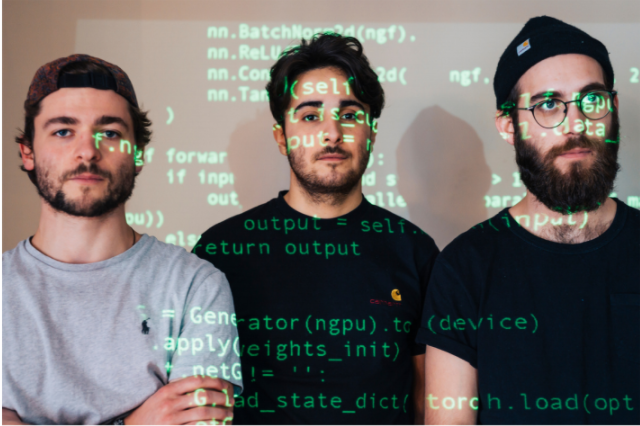
Obvious, the French art collective behind Portrait of Edmond de Belamy (2018), the first AI-generated artwork ever to sell at auction (for a whopping $432,500, no less), is looking to make a splash in the red-hot NFT market. Today, it is dropping a trio of newly minted NFT video portraits in collaboration with blue-chip Paris art gallery Kamel Mennour.
Like the “Famille de Bellamy” series featured in the Christie’s sale, the new series was produced with the aid of Generative Adversarial Networks, a machine learning algorithm, based on a data set of 16,000 portraits from art history. But this time around, the collective used a newer StyleGAN 2 algorithm, and created an animated version of the AI portrait.
The new series, titled “Portraying,” is named after three men who Obvious views as the godfathers to portraiture as we know it today: Renaissance architect and artist Leon Battista Alberti, who published the first scientific study of perspective; American artist John Goffe Rand, who invented the modern tin painting tube; and French artist Louis Daguerre, one of the inventors of photography.
“We wanted to pay tribute to the inventors of those three things,” Gauthier Vernier, who cofounded the collective with Pierre Fautrel and Hugo Caselles-Dupré, told Artnet News. “These are new examples of portraits that could have been possible in art history.”
The works’ individual titles are based on Latin—Perspettiva Albertiana for Alberti, Bellum Tempus for Daguerre, and Acies Color for Rand. Each piece is being sold as an NFT in an edition of one on the NFT platform SuperRare.
“We hope this event will bring the worlds of classical art and cryptoart together, as we believe they can benefit from one another,” the collective told Artnet News in an email.
Obvious, Bellum Tempus (2021). Courtesy of the artist.
The art collective has been minting NFTs since 2017. Typically, their work has sold for about 2 ether, (about $4,000), according to Vernier. He isn’t sure what to expect with the new drop.
“It’s really rare to have such a classical gallery [like Kamel Mennour] in this space, so it’s hard to say if the collectors at the gallery will be interested it, and it’s how to say how the crypto world will react to it,” Vernier admitted. “We’re testing this new hybrid market.”
Obvious, Acies Color (2021). Courtesy of the artist.
Mennour is one of a handful of dealers, including Almine Rech and Pace, cautiously entering the NFT space. “NFTs represent a new medium whose potential interests me and that I want to explore,” Kamel Mennour told Artnet News in an email. “I want to create porosities between my traditional work as a gallerist and the blockchain.”
Obvious, whose work sits at the intersection of art, science, mathematics, and technology, has never had gallery representation before, despite showing at the Hermitage Museum in St. Petersburg and at the Haus der Kunst in Munich.
Obvious, Parietal Burner #2 (2021). The AI-generated work is based on a work by German street artist Bond Truluv and ancient paintings from the French cave art complex Lascaux. Photo courtesy of the artist.
The collective has yet to replicate their headline-making 2018 auction debut at Christie’s, which went for 43 times as much as the house expected. A 2019 followup sale at Sotheby’s saw two works by the collective sell for $25,000 and $16,250, matching the low end of pre-sale estimates.
In December, Obvious unveiled a new body of AI-generated works that blended prehistoric cave art with contemporary street art. The second work in the “Parietal Burner” series, based on Neoline 12, a painting by German street artist Bond Truluv, and one of the ancient paintings from the French cave art complex Lascaux, was released last week. The piece is being sold in an edition of 50, plus one unique NFT.
“We wanted to keep creating the bridge between the oldest and the most recent means of expression,” the collective said.